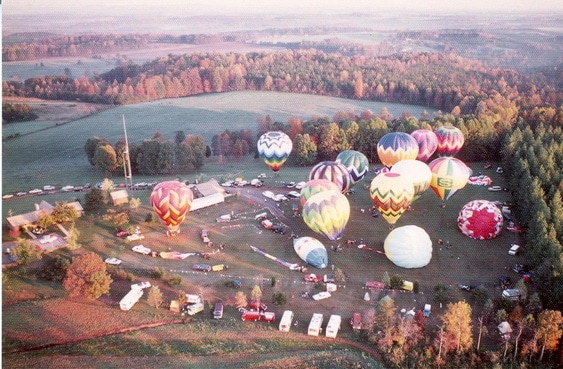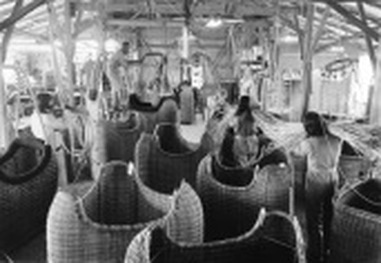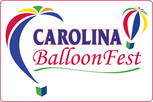Our Rich Aviation History
Our event spans over decades of the area's rich aviation history! Each year, pilots arrive with their hot air balloons to delight and amaze tens of thousands of spectators with a full weekend of mass ascensions, sanctioned competitions, tethered rides & hot air balloon flights. Our traditional Saturday evening balloon glow is a spectacular feature of Carolina BalloonFest! Our festival offers live entertainment, tastes of NC wines & craft beers, fine artisan crafts, kids zone, exhibits, activities and great festival food!
|
1965
Ed Yost with Raven Industries in partnership with the US Air Force, began the development of modern hot air ballooning. With the assistance of Don Piccard and Tracy Barnes, hot air balloon designs were standardized for Federal Aviation Administration certification. This marked the beginning of the hot air balloon industry in the United States. 1974
Meadows founded The National Balloon Rally. In those early years of the rally, most of the flights were made from Balloon Ascensions. Tracy Barnes moved the Balloon Works from Charlotte, NC to Rhyne Aerodrome near Love Valley, NC and started manufacturing hot air balloons in Iredell County. Annual invitations continued and hot air balloonists gathered, camped, flew and shared adventures to foster their passion for flight. They ascended into the skies in their majestic, colorful balloons which complemented the morning sunrises and afternoon sunsets of north Iredell. The events at Rhyne Aerodrome, owned by Raeford and Anna Rhyne, became so popular that a larger venue was necessary to accommodate the growth of enthusiasts and spectators.
|
1969
Bill Meadows and Tracy Barnes made the first flight in Iredell County, NC from Statesville on October 4, 1969. This was the maiden flight for the 'Land of Oz’, one of Tracy’s new design creations, the triangle wicker carriage. Tracy Barnes formed The Balloon Works right here in Statesville, North Carolina to manufacture and sell hot air balloons. The Balloon Works entry into ballooning with safe and affordable sport balloons helped to ignite the market for hot air ballooning in the United States. Also, during this year, Bill Meadows, a native of Statesville, established Balloon Ascensions, LTD (a flight training and promotion company). |

Over the next four decades, the rally’s name, venue locations and hot air balloon manufacturer would change. The Balloon Works is now Firefly Balloons, located in Statesville and continues to manufacture and inspect hot air balloons for hundreds of balloon enthusiasts throughout the United States.
Carolina BalloonFest holds a special place in ballooning history as the 2nd longest (consecutively) held hot air balloon event in the United States! For over 45 years, dedicated community leaders, volunteers and pilots continue to organize and participate in this lofty, annual tradition. There is a trove of treasured memories and imagery beholden to many, many people and they weave a generous story, indeed. The early pioneers and pilots from yesteryear continue to inspire our festival’s longevity.
Carolina BalloonFest holds a special place in ballooning history as the 2nd longest (consecutively) held hot air balloon event in the United States! For over 45 years, dedicated community leaders, volunteers and pilots continue to organize and participate in this lofty, annual tradition. There is a trove of treasured memories and imagery beholden to many, many people and they weave a generous story, indeed. The early pioneers and pilots from yesteryear continue to inspire our festival’s longevity.
|
|
|
ReVisit Carolina BalloonFest Events
The Earliest Hot Air Balloon Pioneers

The Montgolfier brothers, born in Annonay, France, were the inventors of the first practical balloon. The first demonstrated flight of a hot air balloon took place on June 4, 1783, in Annonay, France. Hot air ballooning is the world’s oldest form of aviation and air travel.
Montgolfier Balloon. Joseph and Jacques Montgolfier, paper mill owners, were trying to float bags made of paper and fabric. When the brothers held a flame near the opening at the bottom, the bag (called a balon) expanded with hot air and floated upward. The Montgolfier brothers built a larger paper-lined silk balloon and demonstrated it on June 4, 1783, in the marketplace at Annonay. Their balloon (called a Montgolfiere) lifted 6,562 feet into the air.
First Passengers. On September 19, 1783, in Versailles, a Montgolfiere hot air balloon carrying a sheep, a rooster, and a duck flew for eight minutes in front of Louis XVI, Marie Antoinette, and the French court.
First Manned Flight. On October 15, 1783, Pilatre de Rozier and Marquis d'Arlandes were the first human passengers on a Montgolfiere balloon from central Paris to the city outskirts. The balloon was in free flight, meaning it was not tethered.
Montgolfier Gas. At the time, the Montgolfiers believed they had discovered a new gas (they called Montgolfier gas) that was lighter than air and caused the inflated balloons to rise. In fact, the gas was merely air, which became more buoyant as it was heated.
There were few advances to hot air ballooning for the next 170 years when the rebirth of ballooning took place in the 1960s and advances in technology made it possible to build safe, relatively affordable balloons. Today, over 225 years later, ballooning has become a recreational and competitive sport.
Montgolfier Balloon. Joseph and Jacques Montgolfier, paper mill owners, were trying to float bags made of paper and fabric. When the brothers held a flame near the opening at the bottom, the bag (called a balon) expanded with hot air and floated upward. The Montgolfier brothers built a larger paper-lined silk balloon and demonstrated it on June 4, 1783, in the marketplace at Annonay. Their balloon (called a Montgolfiere) lifted 6,562 feet into the air.
First Passengers. On September 19, 1783, in Versailles, a Montgolfiere hot air balloon carrying a sheep, a rooster, and a duck flew for eight minutes in front of Louis XVI, Marie Antoinette, and the French court.
First Manned Flight. On October 15, 1783, Pilatre de Rozier and Marquis d'Arlandes were the first human passengers on a Montgolfiere balloon from central Paris to the city outskirts. The balloon was in free flight, meaning it was not tethered.
Montgolfier Gas. At the time, the Montgolfiers believed they had discovered a new gas (they called Montgolfier gas) that was lighter than air and caused the inflated balloons to rise. In fact, the gas was merely air, which became more buoyant as it was heated.
There were few advances to hot air ballooning for the next 170 years when the rebirth of ballooning took place in the 1960s and advances in technology made it possible to build safe, relatively affordable balloons. Today, over 225 years later, ballooning has become a recreational and competitive sport.





